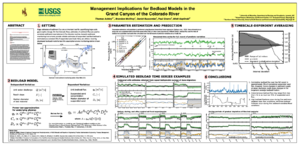Log in (or create account for non-CSDMS members)
Forgot username? Search or email:CSDMSweb@colorado.edu
Browse abstracts
Statistical Bedload Modeling on the Colorado River in Grand Canyon National Park
Acoustic sediment monitoring technology provides a practical means to obtain high resolution estimates of suspended sand flux. However, bed bedload flux can be a significant component of total load and remains difficult to measure directly. In most cases, bedload is treated as a power-law function of water discharge, a constant fraction of suspended sand flux, or ignored. However, bedload flux may vary independently from water discharge or suspended sediment flux in supply-limited rivers due to systematic grain size and reach-geometric effects. We propose a model for bedload flux that enables improved prediction using variables that are routinely measured at acoustic sediment monitoring stations.
Though this model is rooted in causal physical theory, it contains several scaling parameters that must be constrained empirically. To this end, we propose a Bayesian statistical procedure that facilitates propagation of uncertainty from multiple sources of information. Application of this procedure is demonstrated at one monitoring station on the Colorado River in Grand Canyon National Park. Repeat bathymetric surveys of dune migration in the reach adjacent to the monitoring station are used to estimate bedload flux, providing an observational basis for statistical analysis. Parameter estimation and prediction are also informed by data from other rivers, which is incorporated in a hierarchical framework.
We find that conventional methods of estimating bedload flux fail to capture fluctuations driven by the interaction between flow strength and sediment supply, and can introduce large persistent biases to estimates of total load. Our model is applicable in a wide range of scenarios, and substantially reduces the uncertainty associated with estimating bedload flux in sand bed rivers.

